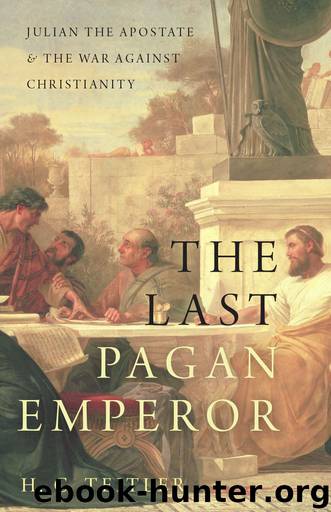The Last Pagan Emperor by Teitler H. C.;

Author:Teitler, H. C.;
Language: eng
Format: epub
Publisher: Oxford University Press
Published: 2017-01-15T00:00:00+00:00
Chapter 2
1. CONSTANTINE: PLRE I, Constantinus 4; Kienast 19962, 298–303; cf., e.g., Neri 1992, Lenski 2006, Schuller and Wolff 2007, Van Dam 2011, Barnes 2011, Maraval 2011, Bardill 2012, Melloni 2013, Potter 2013, Singor 2014, Lenski 2016. MAXENTIUS: PLRE I, Maxentius 5; Kienast 19962, 291–292; Leppin 2007. DREAM: Lact. Mort. pers. 44.5 or VISION: Eus. VC 1.28.2 (with Av. Cameron and Hall 1999, 204–206); cf. Drake 2000, 184 (‘the real issue is not what [Constantine] actually saw but what [he] and others made of it’), Weiss 2003, Singor 2003, Harris 2005, Heinen 2007; see also Ch. 14 n. 10, this volume. BATTLE OF ‘THE MILVIAN BRIDGE’: Maxentius was killed at the bridge, but the battle started at Saxa Rubra (Aur. Vict. Caes. 40.23), Harris 2005, 489–490; Kuhoff 1991 and the relevant pages of the literature on Constantine just cited; for other celestial cross appearances in the fourth century see Nicholson 2000, 312–316 and J. W. Drijvers 2009.
2. IMPACT OF CONSTANTINE’S CONVERSION: Drake 2006; cf. Av. Cameron 2015, 7: ‘… there was no one moment at which the empire became “Christian.” Rather, we must imagine a complex process or processes, unevenly spread and taking far longer than many have supposed in the past.’ PAGANS AND CHRISTIANS BEFORE CONSTANTINE: MacMullen 1984, Lane Fox 1986, Hopkins 1999. PERCENTAGE: Hopkins 1998; for other estimates see Stark 1996, 4–13, with the critical remarks of Bremmer 2010, 45–48.
3. TACITUS: Tac. Ann. 15.44.4; see the provocative postulate of Shaw 2015. TERTULLIAN: Tert. Apol. 40. PERSECUTIONS: De Ste. Croix 1974 and the literature cited in Ch. 7 n. 7, this volume.
4. DECIUS: Rives 1999, Selinger 2002, Bleckmann 2006. DIOCLETIAN: Aubreville 2009 (arguing that the Christians did not provoke the persecution by their behavior, but were chosen as a group of victims because they were ‘different’).
5. TERTULLIAN: Apol. 50.
6. CONSTANTINE’S CHRISTIANITY: Wallraff 2001, 267 (‘We can probably assume correctly that he considered himself a Christian, but what he understood by Christianity was quite different from what we understand, and from what even the contemporary theologians understood by Christianity’), Edwards 2006, Wallraff 2013, Rosen 2013. COINS: Van der Vin 2007.
7. DONATISTS: e.g., Tengström 1964, Grasmück 1964, Frend 19712, Maier 1987–1989, Girardet 1989, Kaufman 2009, Evers 2012, Perrin 2013.
8. ‘ARIAN CONTROVERSY’: ‘ “Arianism,” as an umbrella term (Sammelbegriff) and as a label for particular developments in late-classical Christian theology and doctrine (Lehrbildung), has given rise to an abundance of misunderstandings.’ Thus wrote Brennecke (Brennecke 2014a, 1) in a short, lucid exposition of the main problems. Cf. further Brennecke 2014b and see, e.g., Hanson 1988; Williams 2002; Löhr 2005, Löhr 2006; Galvao-Sobrinho 2006, Lyman 2008, Clauss 2010, 22–72, Martin 2014b. In modern literature the term Arians often denotes only the early followers of Arius, while for later developments Homoians is used. I shall use for both categories ‘Arians,’ placed in inverted commas. Documents with respect to the early phase of the controversy can be found in Opitz 1934–1935 and Brennecke et al. 2007. COUNCIL OF NICAEA: Brennecke 1994, Alberigo 2006.
9. NICENE DECLARATION: Opitz 1935, 51–52, no.
Download
This site does not store any files on its server. We only index and link to content provided by other sites. Please contact the content providers to delete copyright contents if any and email us, we'll remove relevant links or contents immediately.
| France | Germany |
| Great Britain | Greece |
| Italy | Rome |
| Russia | Spain & Portugal |
Fanny Burney by Claire Harman(26528)
Empire of the Sikhs by Patwant Singh(22975)
Out of India by Michael Foss(16791)
Leonardo da Vinci by Walter Isaacson(13188)
Small Great Things by Jodi Picoult(7020)
The Six Wives Of Henry VIII (WOMEN IN HISTORY) by Fraser Antonia(5397)
The Wind in My Hair by Masih Alinejad(5034)
A Higher Loyalty: Truth, Lies, and Leadership by James Comey(4846)
The Lonely City by Olivia Laing(4750)
The Crown by Robert Lacey(4724)
Millionaire: The Philanderer, Gambler, and Duelist Who Invented Modern Finance by Janet Gleeson(4379)
The Iron Duke by The Iron Duke(4293)
Papillon (English) by Henri Charrière(4199)
Sticky Fingers by Joe Hagan(4103)
Joan of Arc by Mary Gordon(4016)
Alive: The Story of the Andes Survivors by Piers Paul Read(3970)
Stalin by Stephen Kotkin(3879)
Aleister Crowley: The Biography by Tobias Churton(3589)
Ants Among Elephants by Sujatha Gidla(3417)
